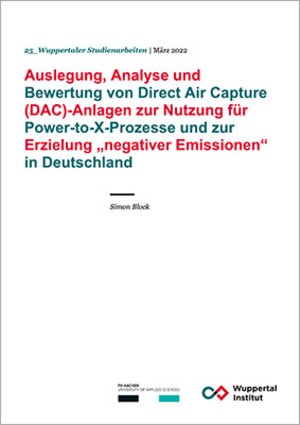Auslegung, Analyse und Bewertung von Direct Air Capture (DAC)-Anlagen zur Nutzung für Power-to-X-Prozesse und zur Erzielung "negativer Emissionen" in Deutschland
Masterarbeit

The direct capture of carbon dioxide (CO2) from the air (direct air capture) is increasingly being discussed as a potential technique of limiting global warming. Precise plannability, low impact on the environment and the output of CO2 in pure form are some of the advantages over other technical approaches for the removal of atmospheric CO2 (negative emission technologies). Subsequently, the CO2 can be stored permanently (direct air capture and sequestration) or used to generate e.g., synthetic fuels (direct air carbon capture and utilization) in power-to-x-processes (ptx).
The aim of the present work is to exploratorily investigate DAC sites in Germany in the context of the climate neutrality targets until 2045. Resulting resource consumption (energy, water, area) and costs, as well as possible savings through waste heat recovery were identified in this review. Specifically, the following research questions were answered: Which technological DAC approaches are feasible for Germany? What quantities of CO2 must be captured to meet the German demand for negative emissions? What resource consumption will occur in Germany if the considered case studies are implemented? What infrastructure is necessary for the implementation? To what extend is a sufficient implementation realizable and what are the limiting factors?
For this purpose, the DAC, ptx and power generation sites (electrical and thermal) were prepared in modular form for the years 2020, 2030, 2040 and 2045. The reference values were chosen to correspond to the DAC module. Four case studies were used to map and analyze possible combinations and implementation paths to 2045. Generally, it is shown that a large-scale deployment of DAC is technically feasible. However, key challenges are the high land and energy requirements. The land requirement results mainly from the use for renewable energy production. Due to the focus on profitable locations, northern and southern regions in Germany are substantial in terms of their wind and solar potential, respectively. An implementation of DAC technology with the goal of permanent CO2 storage is more advantageous at coastal areas in Northern Germany compared to Southern Germany. An installation of the DAC technology in combination with the ptx processes does not seem feasible in Germany due to the high electrical energy demand.
Simon Block:
Auslegung, Analyse und Bewertung von Direct Air Capture (DAC)-Anlagen zur Nutzung für Power-to-X-Prozesse und zur Erzielung "negativer Emissionen" in Deutschland
Wuppertal 2022, ISBN 978-3-946356-27-1
(Wuppertaler Studienarbeiten zur nachhaltigen Entwicklung no. 25)
